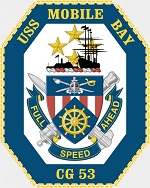Hobby Master HSP1002 US Navy Ticonderoga Class Guided Missile Cruiser - USS Mobile Bay (CG-53) (1:700 Scale)
"Damn the torpedoes. Full speed ahead!"
- Admiral Farragut sailing aboard his flagsphip Hartford while entering Mobile Bay, Alabama, August 23, 1864
 The Ticonderoga class of guided-missile cruisers is a class of warships in the United States Navy, first ordered and authorized in the 1978 fiscal year. The class uses passive phased-array radar and was originally planned as a class of destroyers. However, the increased combat capability offered by the Aegis Combat System and the AN/SPY-1 radar system, together with the capability of operating as a flagship, were used to justify the change of the classification from DDG (guided missile destroyer) to CG (guided-missile cruiser) shortly before the keels were laid down for Ticonderoga and Yorktown.
The Ticonderoga class of guided-missile cruisers is a class of warships in the United States Navy, first ordered and authorized in the 1978 fiscal year. The class uses passive phased-array radar and was originally planned as a class of destroyers. However, the increased combat capability offered by the Aegis Combat System and the AN/SPY-1 radar system, together with the capability of operating as a flagship, were used to justify the change of the classification from DDG (guided missile destroyer) to CG (guided-missile cruiser) shortly before the keels were laid down for Ticonderoga and Yorktown.
Ticonderoga-class guided-missile cruisers are multi-role warships. Their Mk 41 VLS can launch Tomahawk cruise missiles to strike strategic or tactical targets, or fire long-range antiaircraft Standard Missiles for defense against aircraft or anti-ship missiles. Their LAMPS III helicopters and sonar systems allow them to perform antisubmarine missions. Ticonderoga-class ships are designed to be elements of carrier battle groups or amphibious ready groups, as well as performing missions such as interdiction or escort. With upgrades to their AN/SPY-1 phased radar systems and their associated missile payloads as part of the Aegis Ballistic Missile Defense System, members of this class have, in successive tests, repeatedly demonstrated their proficiency as mobile anti-ballistic missile and anti-satellite weaponry platforms.
Of the 27 completed vessels, 19 were built by Ingalls Shipbuilding and eight by Bath Iron Works (BIW). All but one (Thomas S. Gates) of the ships in the class are named for noteworthy events in U.S. military history, and at least twelve share their names with World War II-era aircraft carriers. In 2016, 22 ships were still active and expected to serve for 35 years since commissioning.
Pictured here is a 1:700 scale replica of the Ticonderoga class guided missile cruiser, USS Mobile Bay (CG-53).
Sold Out!
Dimensions:
Length: 11-inches
Release Date: May 2019
 Historical Account: 'SCUD Attack" - USS Mobile Bay (CG-53) is a Ticonderoga class guided-missile cruiser serving in the United States Navy. She is named for the naval Battle of Mobile Bay during the American Civil War in 1864.
Historical Account: 'SCUD Attack" - USS Mobile Bay (CG-53) is a Ticonderoga class guided-missile cruiser serving in the United States Navy. She is named for the naval Battle of Mobile Bay during the American Civil War in 1864.
After commissioning, Mobile Bay joined the U.S. Atlantic Fleet, arriving at her Mayport, Florida, homeport in March 1987. Following a year of crew qualifications, tests and systems trials, Mobile Bay embarked on her maiden deployment on 11 May 1989. During this cruise, Mobile Bay earned her first two awards: the Sea Service Deployment Ribbon and the Armed Services Expeditionary Medal, for operations conducted in the Gulf of Oman.
In June 1990, Mobile Bay shifted homeports from Mayport, Florida to Yokosuka, Japan. Shortly thereafter, she deployed in August 1990 in support of Operation Desert Shield and Operation Desert Storm, becoming the first AEGIS cruiser to circumnavigate the globe. In the Persian Gulf, the ship distinguished herself by becoming the first Battle Force Anti-Air Warfare Commander to control a four-carrier Task Force. Mobile Bay launched 22 Tomahawk land-attack cruise missile strikes, and performed as the Battle Force Anti-Surface Warfare Commander targeting Iraqi naval vessels and directing carrier-launched attack aircraft to destroy 38 Iraqi naval vessels resulting in the complete neutralization of the Iraqi Navy.
In February 1991, the Tactical Information Coordinator (TIC) aboard Mobile Bay, reported SPY-1 Radar acquisitions of what appeared to be SCUD missile launches that were detected over Saudi Arabia. These tracks were reported over Data Systems Administration (DSA) and Anti-Air Warfare Coordination and Reporting (AAWC&R) voice networks and were confirmed to be valid targets by Patriot Batteries who engaged these SCUDs.
In May 1991, Mobile Bay was ordered to Subic Bay, Republic of the Philippines, to participate in Operation Fiery Vigil, the evacuation of thousands of people displaced by the volcanic eruption of Mt. Pinatubo. In December 1991, Mobile Bay began work-ups for a spring 1992 Persian Gulf deployment.
On April 15th, 1992, Mobile Bay once again set sail for the Persian Gulf. En route, the ship and crew visited Sydney, Australia, to represent the U. S. Navy at the 50th Anniversary celebration of the Battle of Coral Sea. Sailing through the Straits of Hormuz in late May 1992, the ship began duties as the Persian Gulf Anti-Air Warfare Commander. Mobile Bay also played a vital role in Operation Southern Watch, the enforcement of the U. N.-mandated "No Fly Zone" over Southern Iraq. Returning to Japan in October, Mobile Bay participated in ANNUALEX-92, a major naval exercise involving units of the U. S. Navy and the Japanese Maritime Self Defense Force. Mobile Bay served as the Anti-Air Warfare Commander for a joint U. S. - Japanese flotilla.






